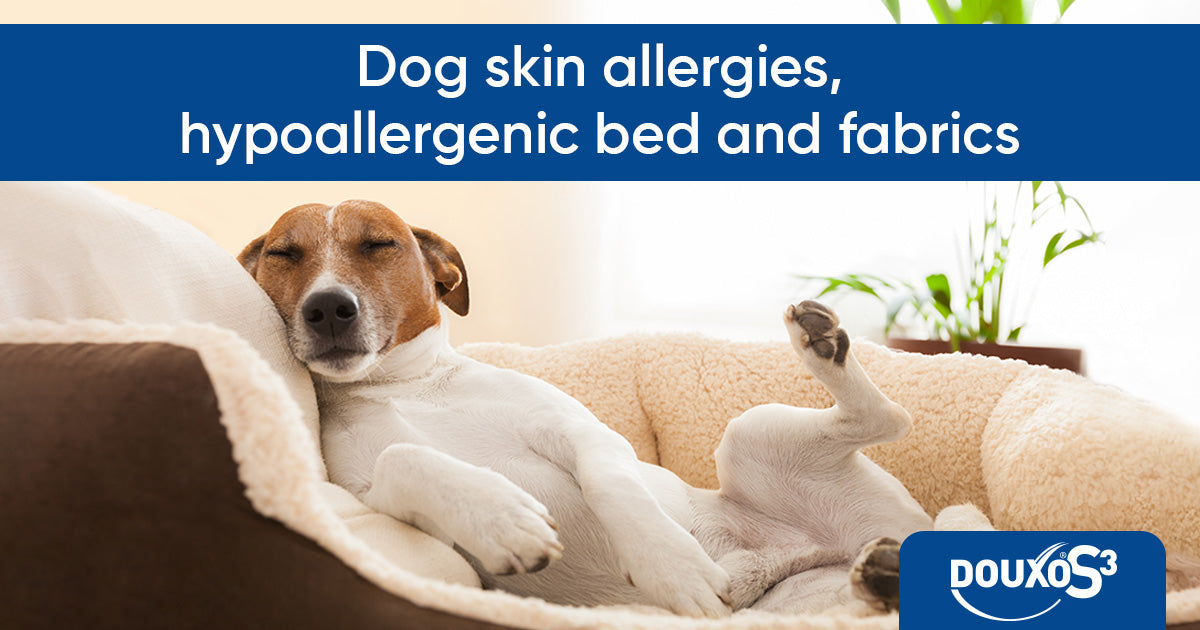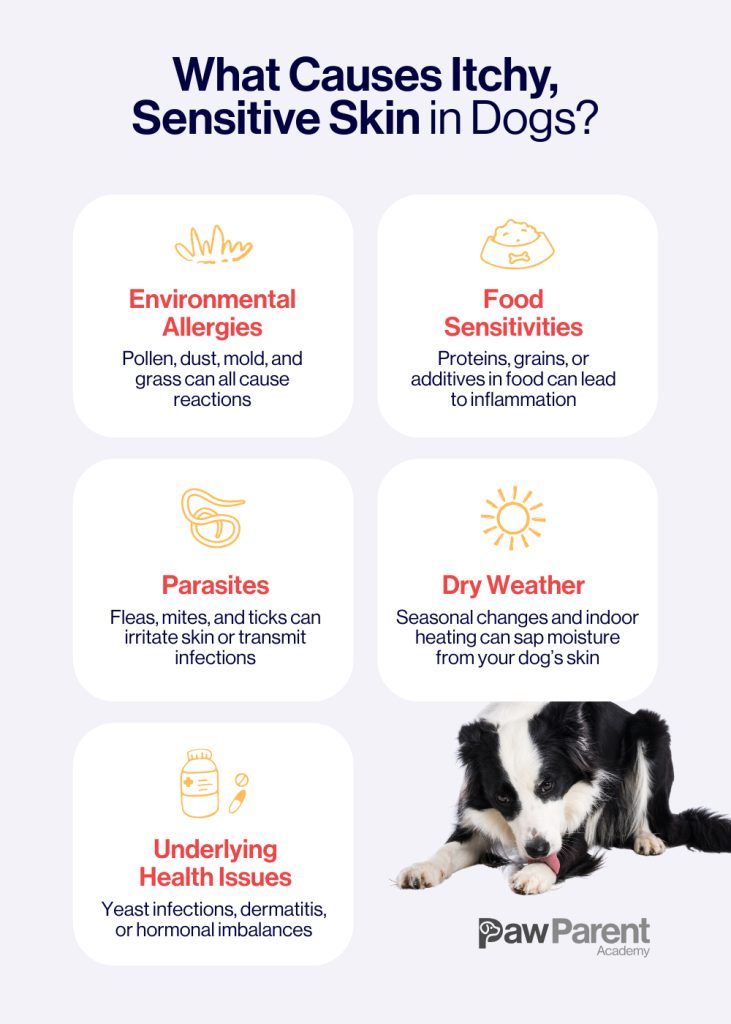If your dog suffers from skin allergies, you probably wonder how often you should bathe them to keep their skin healthy without causing more irritation. Bathing too little might leave allergens and irritants behind, but bathing too often can dry out your dog’s skin and make the problem worse.
You want the best care for your furry friend, and finding the right bathing routine is key to easing their discomfort. You’ll discover simple, effective guidelines to help you decide how often to bathe your dog with skin allergies—so you can keep your pet comfortable and happy every day.
Keep reading to learn what works best for your dog’s unique needs.
Causes Of Skin Allergies In Dogs
Understanding what triggers your dog’s skin allergies can help you manage their condition better. Skin allergies in dogs often come from various sources, and identifying these causes is key to deciding how often to bathe your furry friend. Knowing what sets off the itchiness can also guide you in choosing the right bathing products and routines.
Common Allergens
Many dogs react to allergens that seem harmless to us. These include:
- Pollen:Just like people, dogs can be allergic to pollen from grasses, trees, or weeds.
- Dust mites:Tiny creatures living in your home’s dust can irritate your dog’s skin.
- Food ingredients:Some dogs develop allergies to common foods like beef, chicken, or dairy.
- Fleas:Flea bites can cause severe allergic reactions in sensitive dogs.
- Chemicals:Shampoos, cleaning products, or lawn treatments may trigger allergies.
Have you noticed your dog scratching more after walks or eating certain meals? These observations can help you pinpoint the allergen.
Signs And Symptoms
Allergic reactions show up in many ways on your dog’s skin. Watch for:
- Redness and inflammation
- Excessive scratching or licking
- Hair loss or thinning patches
- Scaly or flaky skin
- Recurring ear infections
It’s easy to miss subtle signs, so pay attention to changes in your dog’s behavior or coat condition. Have you noticed your dog grooming more than usual or showing discomfort after exposure to certain environments?
Benefits Of Bathing For Allergic Dogs
Bathing dogs with skin allergies offers many benefits. It is a crucial part of their care routine. Regular baths can help manage symptoms and improve comfort. Allergic dogs often suffer from itching and irritation. Bathing can provide relief and promote healthier skin.
Removing Allergens
Bathing helps remove allergens from a dog’s coat and skin. Dust, pollen, and other irritants can cling to fur. Regular washing reduces these allergens significantly. This process helps prevent allergic reactions. It keeps your dog more comfortable and less itchy.
Soothing Irritated Skin
Bathing can soothe irritated skin effectively. Use hypoallergenic shampoos for best results. These shampoos are gentle and free from harsh chemicals. They help calm redness and reduce inflammation. This leads to less discomfort for your furry friend.
Ideal Bathing Frequency
Finding the ideal bathing frequency for a dog with skin allergies can feel like walking a tightrope. Bathe too often, and you risk drying out your dog’s sensitive skin. Bathe too little, and allergens may linger, causing discomfort. Understanding the right balance is key to keeping your furry friend comfortable and healthy.
Factors Influencing Frequency
Every dog is different, and several factors affect how often you should bathe your allergic dog.
- Severity of Allergies:Dogs with severe skin allergies may need more frequent baths to remove allergens and soothe irritation.
- Type of Shampoo:Medicated shampoos designed for allergies can allow for more frequent bathing without drying out the skin.
- Environment:Dogs exposed to pollen, dust, or frequent outdoor activity might require baths more often to clear irritants.
- Skin Condition:If your dog’s skin is flaky or oily, this changes how often a bath will be beneficial.
Think about your dog’s daily routine and skin reactions. How does their skin look a few days after a bath? This can guide your schedule.
Expert Recommendations
Veterinarians often suggest bathing dogs with skin allergies about once every 1 to 2 weeks. This frequency helps remove allergens without stripping essential oils from the skin.
Some vets recommend using gentle, hypoallergenic shampoos or those containing oatmeal or aloe vera. These ingredients help calm irritated skin and maintain moisture.
Listening to your vet’s advice tailored to your dog’s specific allergies is crucial. Have you noticed improvements after adjusting your bathing routine? That feedback is invaluable.

Credit: www.pawparentacademy.com
Choosing The Right Shampoo
Choosing the right shampoo for your dog with skin allergies can make a huge difference in their comfort and healing process. Not every shampoo is safe or effective for sensitive skin. Understanding the options and what to avoid helps you make a smart choice that protects your dog’s skin and fur.
Medicated Vs. Natural Options
Medicated shampoos often contain ingredients designed to treat specific skin conditions like bacterial infections, fungal problems, or severe itching. These shampoos can provide quick relief but might have stronger chemicals that could irritate some dogs.
Natural shampoos, on the other hand, use plant-based ingredients and fewer chemicals. They are gentler and can be a good choice for mild allergies or as a maintenance wash. However, they may not be strong enough if your dog’s skin condition is severe or infected.
Have you noticed how some shampoos soothe your dog immediately, while others seem to make itching worse? This difference often comes down to whether the shampoo is medicated or natural. Your vet can help decide which fits your dog’s needs best.
Ingredients To Avoid
Some common shampoo ingredients can worsen skin allergies rather than help. Avoid shampoos containing:
- Fragrances and dyes:These often cause irritation and allergic reactions.
- Sulfates:Such as sodium lauryl sulfate, which can strip natural oils and dry out skin.
- Parabens and formaldehyde releasers:Used as preservatives but linked to skin sensitivity.
- Alcohol:Can dry and inflame sensitive skin.
Choosing a shampoo without these ingredients reduces the risk of flare-ups. Always check the label carefully before buying. Could a hidden ingredient be the reason your dog’s allergies worsen after a bath?
Bathing Techniques For Sensitive Skin
Bathing a dog with sensitive skin requires gentle care. Proper techniques protect the skin and avoid irritation. Using the right water temperature and drying methods helps keep your dog’s skin healthy. This section explains how to bathe dogs with skin allergies safely and comfortably.
Water Temperature And Pressure
Use lukewarm water to soothe sensitive skin. Water that is too hot or too cold can cause discomfort. Keep the water temperature steady throughout the bath. Avoid sudden changes that might startle or stress your dog.
Use a gentle water flow. High water pressure can hurt delicate skin. A soft spray or a cup to pour water slowly works best. Always test the water pressure on your hand before applying it to your dog.
Drying Tips
Pat your dog dry with a soft towel. Avoid rubbing, which can irritate the skin. Use multiple towels if needed to absorb moisture fully. Keep your dog in a warm place during drying to prevent chills.
If using a blow dryer, select the lowest heat setting. Hold the dryer at a safe distance to avoid burning. Move the dryer constantly to prevent heat buildup on one spot. Let your dog air dry if they dislike blow dryers.
Additional Skin Care Tips
Proper skin care goes beyond just bathing. Dogs with skin allergies need extra attention to keep their skin healthy and comfortable. Small changes in diet and environment can make a big difference in your dog’s skin condition. These tips help reduce itching and inflammation, supporting overall skin health.
Diet And Supplements
Nutrition plays a vital role in skin health. Feeding a balanced diet rich in omega-3 and omega-6 fatty acids helps reduce inflammation. These fats support the skin’s natural barrier and improve coat shine.
Consider adding supplements like fish oil or flaxseed oil after consulting your vet. These oils provide essential nutrients that soothe irritated skin. Avoid foods that trigger allergic reactions, such as certain proteins or grains. Watch for signs of food allergies like redness or itching.
Environmental Management
Keeping your dog’s environment clean reduces allergen exposure. Regularly wash bedding, toys, and blankets to remove dust and pollen. Vacuum your home often to cut down on dust mites and pet dander.
Limit your dog’s time in areas with tall grass or heavy pollen, especially during allergy seasons. Use air purifiers indoors to improve air quality. Keep your dog’s skin dry and avoid harsh chemicals or sprays on their coat.
When To Consult A Veterinarian
Knowing when to consult a veterinarian is crucial if your dog has skin allergies. Bathing can help, but some symptoms need professional attention to avoid worsening your dog’s condition. Paying attention to changes in your dog’s skin and behavior will help you decide when it’s time to seek expert advice.
Persistent Symptoms
If your dog’s itching, redness, or irritation doesn’t improve after a few baths, it’s a sign to contact your vet. Sometimes, allergies can lead to infections that require medication beyond shampoos. Watch out for thickened skin, hair loss, or sores that keep coming back despite your care.
Also, if your dog seems uncomfortable, restless, or is scratching more than usual, don’t wait. Persistent symptoms can mean the allergy is more severe or that there is a secondary problem. Your vet can help identify the root cause and prevent further damage.
Treatment Options
A vet can offer treatments tailored to your dog’s specific allergy type and severity. They might suggest medicated shampoos, oral medications, or allergy shots that you can’t get over the counter. Sometimes, diet changes are necessary to reduce allergic reactions.
Discussing treatment options with a professional ensures you’re not over-bathing, which can strip your dog’s skin of natural oils and make symptoms worse. Your vet can also recommend the right frequency and products for bathing, making your efforts more effective.
Are you ready to give your dog the relief they deserve? Consulting a veterinarian can save you time and stress while keeping your furry friend comfortable and healthy.

Credit: douxo.de

Credit: www.dandylionworld.com
Frequently Asked Questions
How Often Should Dogs With Skin Allergies Be Bathed?
Dogs with skin allergies should be bathed every 3 to 4 days. Frequent bathing helps remove allergens and soothes irritated skin. Use medicated shampoos recommended by your vet for best results. Avoid over-bathing, which can dry out the skin further.
What Type Of Shampoo Is Best For Allergic Dogs?
Hypoallergenic or medicated shampoos designed for sensitive skin are best. Look for products containing oatmeal, aloe vera, or hydrocortisone. Avoid shampoos with harsh chemicals or fragrances. Always consult your vet before choosing a shampoo to treat your dog’s allergies safely.
Can Bathing Reduce My Dog’s Skin Allergy Symptoms?
Yes, regular bathing can reduce allergens and relieve itching. It removes dirt, pollen, and irritants from the coat. Bathing also helps moisturize and calm inflamed skin. However, it should be part of a broader allergy management plan including vet advice.
Is Over-bathing Harmful To Dogs With Skin Allergies?
Over-bathing can strip natural oils, worsening dryness and irritation. Stick to the vet-recommended bathing schedule, usually every 3-4 days. Use gentle, moisturizing shampoos to protect the skin barrier. Monitor your dog’s skin condition and adjust bathing frequency if needed.
Conclusion
Bathing a dog with skin allergies needs care and patience. Too often can dry their skin, too little may not help. Use gentle shampoos made for sensitive skin. Watch your dog’s reaction after each bath. Consult your vet to set the best bathing schedule.
Keeping skin clean and moisturized helps reduce itching. Small changes can make a big difference. Healthy skin means a happier dog. Keep learning and observing your dog’s needs closely.

Emily Barker is the founder of ChillDogLife.com, a space dedicated to helping pup parents discover the best dog products, lifestyle tips, and cozy ideas for happier homes.
A lifelong dog lover, Emily combines her passion for pets with a knack for research to share trusted recommendations on everything from toys and furniture to health and everyday care.
Her goal is simple: to make life easier, stylish, and more joyful for dogs and the people who love them.







